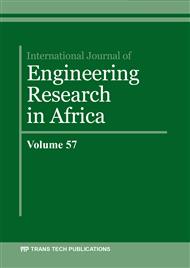[1]
H. Klee, Briefing: The cement sustainability initiative, 2004.
Google Scholar
[2]
S.O. Odeyemi, O.D. Atoyebi, E.K. Ayo, Effect of Guinea Corn Husk Ash on the Mechanical Properties of Lateritic Concrete, IOP Conf. Ser. Earth Environ. Sci. 445 (2020) 1–11.
DOI: 10.1088/1755-1315/445/1/012034
Google Scholar
[3]
M.A. Anifowose, A.O. Adeyemi, S.O. Odeyemi, R. Abdulwahab, R.B. Mudashiru, Comparative study of Ikirun and Osogbo Slag on concrete grade 20, Niger. J. Technol. 38 (2019) 283–288.
DOI: 10.4314/njt.v38i2.2
Google Scholar
[4]
S.O. Odeyemi, R. Abdulwahab, A.A. Abdulsalam, M.A. Anifowose, Bond and Flexural Strength Characteristics of Partially Replaced Self-Compacting Palm Kernel Shell Concrete, Malaysian J. Civ. Eng. 31 (2019) 1–7.
DOI: 10.11113/mjce.v31n2.535
Google Scholar
[5]
S.O. Odeyemi, M.A. Anifowose, M.O. Oyeleke, A.O. Adeyemi, S.B. Bakare, Effect of Calcium Chloride on the Compressive Strength of Concrete Produced from Three Brands of Nigerian Cement, Am. J. Civ. Eng. 3 (2015) 1–5.
Google Scholar
[6]
E.J. Elizondo-Martinez, V.C. Andres-Valeri, J. Rodriguez-Hernandez, D. Castro-Fresno, Proposal of a new porous concrete dosage methodology for pavements, Materials (Basel). 12 (2019) 1–16.
DOI: 10.3390/ma12193100
Google Scholar
[7]
Hariyadi, H. Tamai, Enhancing the performance of porous concrete by utilizing the pumice aggregate, Procedia Eng. 125 (2015) 732–738.
DOI: 10.1016/j.proeng.2015.11.116
Google Scholar
[8]
J.T. Kevern, V.R. Schaefer, K. Wang, Mixture proportion development and performance evaluation of pervious concrete for overlay applications, ACI Mater. J. 108 (2011) 439–448.
DOI: 10.14359/51683117
Google Scholar
[9]
K.H. Obla, Pervious concrete - An overview, Indian Concr. J. 84 (2010) 9–18.
Google Scholar
[10]
Y. Qin, H. Yang, Z. Deng, J. He, Water permeability of pervious concrete is dependent on the applied pressure and testing methods, Adv. Mater. Sci. Eng. 2015 (2015) 1–7.
DOI: 10.1155/2015/404136
Google Scholar
[11]
N.H. Abd Halim, H. Md Nor, R.P. Jaya, A. Mohamed, M.H. Wan Ibrahim, N.I. Ramli, F.M. Nazri, Permeability and Strength of Porous Concrete Paving Blocks at Different Sizes Coarse Aggregate, J. Phys. Conf. Ser. 1049 (2018).
DOI: 10.1088/1742-6596/1049/1/012028
Google Scholar
[12]
S. Kubba, Chapter 6 - Choosing Materials and Products, in: Green Constr. Proj. Manag. Cost Overs., 2010: p.221–266.
Google Scholar
[13]
G.C. Wang, Chapter 11 - Slag use as an aggregate in concrete and cement-based materials, in: Util. Slag Civ. Infrastruct. Constr., 2016: p.239–274.
DOI: 10.1016/b978-0-08-100381-7.00011-2
Google Scholar
[14]
L. Moretti, P. Di Mascio, C. Fusco, Porous concrete for pedestrian pavements, Water (Switzerland). 11 (2019).
DOI: 10.3390/w11102105
Google Scholar
[15]
A.S. Agar-Ozbek, J. Weerheijm, E. Schlangen, K. van Breugel, Investigating porous concrete with improved strength: Testing at different scales, Constr. Build. Mater. 41 (2013) 480–490.
DOI: 10.1016/j.conbuildmat.2012.12.040
Google Scholar
[16]
M. Rangelov, S. Nassiri, L. Haselbach, K. Englund, Using carbon fiber composites for reinforcing pervious concrete, Constr. Build. Mater. 126 (2016) 875–885.
DOI: 10.1016/j.conbuildmat.2016.06.035
Google Scholar
[17]
F. Giustozzi, Polymer-modified pervious concrete for durable and sustainable transportation infrastructures, Constr. Build. Mater. 111 (2016) 502–512.
DOI: 10.1016/j.conbuildmat.2016.02.136
Google Scholar
[18]
A. Bonicelli, G.M. Arguelles, L.G.F. Pumarejo, Improving Pervious Concrete Pavements for Achieving More Sustainable Urban Roads, Procedia Eng. 161 (2016) 1568–1573.
DOI: 10.1016/j.proeng.2016.08.628
Google Scholar
[19]
E. Khankhaje, M.R. Salim, J. Mirza, M.W. Hussin, M. Rafieizonooz, Properties of sustainable lightweight pervious concrete containing oil palm kernel shell as coarse aggregate, Constr. Build. Mater. 126 (2016) 1054–1065. doi:https://doi.org/10.1016/j.conbuildmat.2016.09.010.
DOI: 10.1016/j.conbuildmat.2016.09.010
Google Scholar
[20]
Y.J. Kim, A. Gaddafi, I. Yoshitake, Permeable concrete mixed with various admixtures, Mater. Des. 100 (2016) 110–119. doi:https://doi.org/10.1016/j.matdes.2016.03.109.
DOI: 10.1016/j.matdes.2016.03.109
Google Scholar
[21]
J. Li, Y. Zhang, G. Liu, X. Peng, Preparation and performance evaluation of an innovative pervious concrete pavement, Constr. Build. Mater. 138 (2017) 479–485. doi:https://doi.org/10.1016/j.conbuildmat.2017.01.137.
DOI: 10.1016/j.conbuildmat.2017.01.137
Google Scholar
[22]
Y. Chen, K. Wang, X. Wang, W. Zhou, Strength, fracture and fatigue of pervious concrete, Constr. Build. Mater. 42 (2013) 97–104. doi:https://doi.org/10.1016/j.conbuildmat.2013.01.006.
DOI: 10.1016/j.conbuildmat.2013.01.006
Google Scholar
[23]
W. Shen, L. Shan, T. Zhang, H. Ma, Z. Cai, H. Shi, Investigation on polymer–rubber aggregate modified porous concrete, Constr. Build. Mater. 38 (2013) 667–674. doi:https://doi.org/10.1016/j.conbuildmat.2012.09.006.
DOI: 10.1016/j.conbuildmat.2012.09.006
Google Scholar
[24]
M. Lee, Y. Huang, T. Chang, C. Pao, Experimental Study of Pervious Concrete Pavement, in: Emerg. Technol. Mater. Des. Rehabil. Insp. Roadw. Pavements; Am. Soc. Civ. Eng. Reston, VA, USA, 2011: p.93–99.
Google Scholar
[25]
B. Rehder, K. Banh, N. Neithalath, Fracture behavior of pervious concretes: The effects of pore structure and fibers, Eng. Fract. Mech. 118 (2014) 1–16. doi:https://doi.org/10.1016/j.engfracmech.2014.01.015.
DOI: 10.1016/j.engfracmech.2014.01.015
Google Scholar
[26]
R. Zhong, K. Wille, Compression response of normal and high strength pervious concrete, Constr. Build. Mater. 109 (2016) 177–187. doi:https://doi.org/10.1016/j.conbuildmat. 2016.01.051.
DOI: 10.1016/j.conbuildmat.2016.01.051
Google Scholar
[27]
N.K. Sharma, P. Kumar, S. Kumar, B.S. Thomas, R.C. Gupta, Properties of concrete containing polished granite waste as partial substitution of coarse aggregate, Constr. Build. Mater. 151 (2017) 158–163.
DOI: 10.1016/j.conbuildmat.2017.06.081
Google Scholar
[28]
B.I.O. Dahunsi, N.A. Sulymon, Gravel mining and supply for construction-a case study of Southwestern Nigeria, Adv. Mater. Res. 824 (2013) 44–50.
DOI: 10.4028/www.scientific.net/amr.824.44
Google Scholar
[29]
N. Sulymon, O. Ofuyatan, O. Adeoye, S. Olawale, A. Busari, G. Bamigboye, J. Jolayemi, Engineering properties of concrete made from gravels obtained in Southwestern Nigeria, Cogent Eng. 4 (2017) 1–11.
DOI: 10.1080/23311916.2017.1295793
Google Scholar
[30]
BS EN 1097-6:2013, Tests for mechanical and physical properties of aggregates. Determination of particle density and water absorption, British Standard Institution, London., (2013).
Google Scholar
[31]
BS EN 197-1:2011, Cement-Composition, specifications and conformity criteria for common cements, British Standards, (2011).
Google Scholar
[32]
BS 1881:103, Testing Concrete - Method for Determination of Compacting Factor, British Standards, (1983).
Google Scholar
[33]
BS EN 12390-3:2009, Testing Hardened Concrete - Compressive Strength of Test Specimens, British Standards, (2009).
Google Scholar
[34]
BS EN 12390-8:2000, British Standard Testing hardened concrete Ð Part 8 : Depth of penetration of water, (2003).
Google Scholar


